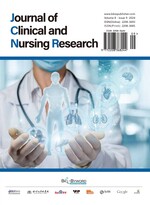Abstract
Objective: To measure the self-efficacy of nursing students taught using both flipped and traditional classroom modalities. Method: A quantitative research design was employed. The control group was taught using the traditional classroom model, while the experimental group utilized the flipped classroom model. The study population consisted of undergraduate nursing majors at Shandong University of Traditional Chinese Medicine. Two out of twelve classes were selected through random sampling. Results: The study presents an analysis of the t-test results using SPSS, which shows a significant difference when the calculated P-value falls between 0.00 and 0.05. The P-value obtained was 0.00, indicating a statistically significant difference. Conclusion: The teaching model, whether flipped or traditional, has an impact on nursing students’ self-efficacy. Students in the flipped classroom exhibited higher self-efficacy in mastering the curriculum.
References
Overmyer GR, 2014, The Flipped Classroom Model for College Algebra: Effects on Student Achievement, dissertation, Colorado State University.
Bergmann J, Sams A, 2012, Flip Your Classroom: Reach Every Student in Every Class Every Day. International Society for Technology in Education, Washington DC, 120–190.
Njie-Carr VP, Ludeman E, Lee MC, et al., 2017, An Integrative Review of Flipped Classroom Teaching Models in Nursing Education. J Prof Nurs, 33(2): 133–144. https://doi.org/10.1016/j.profnurs.2016.07.001
Bandura A, 1989, Human Agency in Social Cognitive Theory. Am Psychol, 44(9): 1175–1184. https://doi.org/10.1037/0003-066x.44.9.1175
Bandura A, 1997, Self-Efficacy: Toward A Unifying Theory of Behavioral Change. Psychol Rev, 84(2): 191–215. https://doi.org/10.1037//0033-295x.84.2.191
Zimmerman BJ, 2000, Attaining Self-Regulation: A Social Cognitive Perspective, in Boekaerts M, Pintrich PR, Zeidner M (eds.), Handbook of Self-Regulation. Academic Press, San Diego CA, 13–39. http://dx.doi.org/10.1016/B978-012109890-2/50031-7
Sadi O, Uyar M, 2013, Relationship Between Self Efficacy, Self-Regulated Learning Strategies and Achievement: A Path Model. Journal of Baltic Science Education, 12(1): 21–33. https://doi.org/10.33225/jbse/13.12.21
Al-Harthy IS, Was CA, Isaacson RM, 2010, Efficacy and Meta-Cognitive Self-Regulation A Path Analysis. International Journal of Education, 2(1): 357. https://doi.org/10.5296/ije.v2i1.357
Zimmerman BJ, 2008, Investigating Self-Regulation and Motivation: Historical Background, Methodological Developments, and Future Prospects. American Educational Research Journal, 45(1): 166–183. https://doi.org/10.3102/0002831207312909
Komarraju M, Nadler D, 2013, Self-Efficacy and Academic Achievement: Why Do Implicit Beliefs, Goals, and Effort Regulation Matter? Learning and Individual Differences, 25: 67–72. http://dx.doi.org/10.1016/j.lindif.2013.01.005
Baker JW, 2000, The Classroom Flip: Using Web Course Management Tools to Become the Guide by the Side. 11th International Conference on College Teaching and Learning, Jacksonville, Florida Community College.
Lage MJ, Platt GJ, Treglia M, 2000, Inverting the Classroom: A Gateway to Creating an Inclusive Learning Environment. The Journal of Economic Education, 31: 30–43. http://dx.doi.org/10.2307/1183338
Sandhu S, Sankey MD, Donald P, 2019, Developing A Flipped Classroom Framework to Improve Tertiary Education Students’ Learning Engagements in India. The International Journal of Education and Development using Information and Communication Technology, 15(2): 31–44.
UNSW, 2019, The Flipped Classroom Teaching for Learning, viewed March 15,2024, https://teaching.unsw.edu.au/flipped-classroom
Butt A, 2014, Student Views on The Use of A Flipped Classroom Approach: Evidence from Australia. Business Education and Accreditation, 6(1): 33–43.
Jamaludin R, Osman SZM, 2014, The Use of A Flipped Classroom to Enhance Engagement and Promote Active Learning. Journal of Education and Practice, 5(2): 124–131.
Bandura A, 1977, Self-Efficacy: Toward A Unifying Theory of Behavioral Change. Psychological Review, 84(2): 191–215. https://doi.org/10.1037/0033-295X.84.2.191
Bandura A, National Institute of Mental Health, 1986, Social Foundations of Thought and Action: A Social Cognitive Theory. Prentice-Hall, Inc., Saddle River NJ.
Bandura A, 1982, Self-Efficacy Mechanism in Human Agency. American Psychologist, 37(2): 122–147. https://doi.org/10.1037/0003-066X.37.2.122
Fisher DM, Ragsdale JM, Fisher ECS, 2018, The Importance of Definitional and Temporal Issues in the Study of Resilience. Applied Psychology, 68(4): 583–620. https://doi.org/10.1111/apps.12162
Chen Hsieh WC, Wu WCV, Marek MW, 2017, Using the Flipped Classroom to Enhance EFL Learning. Computer Assisted Language Learning, 30(1–2): 1–21. https://doi.org/10.1080/09588221.2015.1111910
